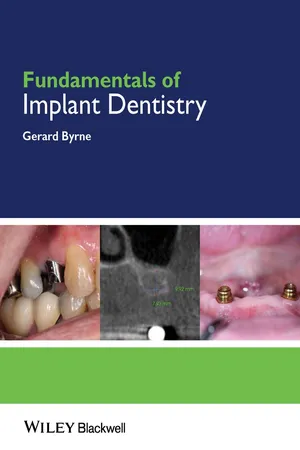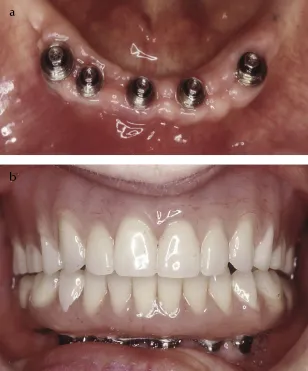
- English
- ePUB (mobile friendly)
- Available on iOS & Android
eBook - ePub
Fundamentals of Implant Dentistry
About this book
Fundamentals of Implant Dentistry is a basic guide to foundational knowledge and skills and their application in clinical practice. More comprehensive than a procedural atlas and more accessible than a specialist reference, this text is an indispensable tool for dental students and clinicians beginning work with dental implants.
Fundamentals of Implant Dentistry provides a concise yet comprehensive look at the basic background and science of implantology and includes practical, evidence?based instruction on common procedures such as single implant crowns, bridges and overdentures. Well?illustrated with clear line drawings and clinical photos, the book serves as the perfect introduction to this exciting area of dentistry.
Fundamentals of Implant Dentistry provides a concise yet comprehensive look at the basic background and science of implantology and includes practical, evidence?based instruction on common procedures such as single implant crowns, bridges and overdentures. Well?illustrated with clear line drawings and clinical photos, the book serves as the perfect introduction to this exciting area of dentistry.
Frequently asked questions
Yes, you can cancel anytime from the Subscription tab in your account settings on the Perlego website. Your subscription will stay active until the end of your current billing period. Learn how to cancel your subscription.
No, books cannot be downloaded as external files, such as PDFs, for use outside of Perlego. However, you can download books within the Perlego app for offline reading on mobile or tablet. Learn more here.
Perlego offers two plans: Essential and Complete
- Essential is ideal for learners and professionals who enjoy exploring a wide range of subjects. Access the Essential Library with 800,000+ trusted titles and best-sellers across business, personal growth, and the humanities. Includes unlimited reading time and Standard Read Aloud voice.
- Complete: Perfect for advanced learners and researchers needing full, unrestricted access. Unlock 1.4M+ books across hundreds of subjects, including academic and specialized titles. The Complete Plan also includes advanced features like Premium Read Aloud and Research Assistant.
We are an online textbook subscription service, where you can get access to an entire online library for less than the price of a single book per month. With over 1 million books across 1000+ topics, we’ve got you covered! Learn more here.
Look out for the read-aloud symbol on your next book to see if you can listen to it. The read-aloud tool reads text aloud for you, highlighting the text as it is being read. You can pause it, speed it up and slow it down. Learn more here.
Yes! You can use the Perlego app on both iOS or Android devices to read anytime, anywhere — even offline. Perfect for commutes or when you’re on the go.
Please note we cannot support devices running on iOS 13 and Android 7 or earlier. Learn more about using the app.
Please note we cannot support devices running on iOS 13 and Android 7 or earlier. Learn more about using the app.
Yes, you can access Fundamentals of Implant Dentistry by Gerard Byrne in PDF and/or ePUB format, as well as other popular books in Medicine & Dentistry. We have over one million books available in our catalogue for you to explore.
Information
1
Introduction to Dental Implants
- 1.1 Introduction
- 1.2 Tooth loss
- 1.3 Early dental implants
- 1.4 Pioneering implant research
- 1.5 Commercial implant history
- 1.6 Notable implant “milestones”
- 1.7 Criteria for implant success
- 1.8 Clinical studies, implant validation
- 1.9 Implant regulation
- 1.10 Research and development
- 1.11 Summary
1.1 Introduction
Implantation involves the embedding of a native or foreign tissue or substance within body tissues. The end point of dental implantation is recovered dental function and aesthetics.
It has long been a common refrain in dental practice for patients to express the desire for a “screw-in” tooth replacement. The dream of predictable stable implant prostheses and the current concept of implant “osseointegration” became a reality through the pioneering research of Brånemark and coworkers in Sweden from the mid-1960s, and Schroeder and coworkers in Switzerland from the mid-1970s. (Brånemark et al. 1969, 1977, 1985; Albrektsson et al. 1981; Schroeder et al. 1991, 1996). From a clinical standpoint, research has shown that modern titanium (Ti) endosseous implants have an overall survival rate of 90–95%.
Beginning in 1952 Brånemark discovered, in the course of vital microscopic studies of blood rheology and bone healing, that titanium (Ti) optical chambers inserted in rabbit bone became firmly attached to the bone and were difficult to remove for reuse; the living bone had “bonded” to the Ti. Later in the 1960s, Brånemark further studied this phenomenon in dogs and, from his perspective as an orthopedic surgeon, contemplated the idea of using Ti implants for artificial joints, bone repair, and edentulism. Brånemark resolved to work primarily on the rehabilitation of edentulism. He coined the term “osseointegration” to describe the stable functional bond between the metal Ti screws and living bone. Brånemark and his team, with meticulous attention to detail, adherence to sound biological principles, and long-term continuous study, proceeded to develop a standard set of protocols for implant rehabilitation of edentulism. Brånemark et al. (1985) postulated a two-stage surgical approach allowing the submerged implant to heal or integrate for 3–6 months before exposure to the oral environment (Fig. 1.1a,b). Schroeder et al. (1996) in later independent studies postulated a one-stage surgery, a nonsubmerged technique, with transmucosal healing and a shorter healing period of 3–4 months. Otherwise, the techniques were similar in that both used Ti, careful atraumatic site preparation, and prolonged healing.

While Brånemark's vision is now accepted and lauded, it is interesting to note that there was significant controversy and skepticism at the time in his native Sweden regarding this new implant method (Albrektsson and Sennerby 2005). In a 2005 commentary, Brånemark suggested that we need to continue to focus on the “decisive effect of functional load on the healing process and remodeling of bone and marrow” rather than focus on the “hardware.” He further commented that: “the mouth is a much more important part of the human body than medicine and controlling agencies recognize.”
1.2 Tooth Loss
Consequences of Tooth Loss on Alveolar Bone
Bone needs functional stimulation to maintain its form and density. The alveolar bone grows with the developing and erupting teeth. Wolff's Law states that bone remodels (changes its internal and external architecture) in relation to the forces applied. The loss of a tooth and thence loss of functional bone stimulation, leads to bone atrophy and a reduction in alveolar ridge width and height (Tallgren et al. 1980). A removable prosthesis does not stimulate and maintain bone but serves to exacerbate ridge resorption. Ridge resorption of up to 22% vertically and 63% horizontally occurs within 6 months after tooth extraction in otherwise dentate patients (Tan et al. 2012). During the first year following tooth extraction, there is an average ridge width decrease of 25%, and an average 4.0 mm height reduction. Implants retain alveolar bone height, but do not completely prevent some alveolar resorption when placed immediately into tooth extraction sites.
Demographics of Tooth Loss
Age is related directly to every indicator of tooth loss: caries, periodontal disease, endodontic problems, and fracture (Meskin et al. 1988; Misch 2007; Jokstad 2009). The average number of lost teeth increases with age (Müller et al. 2007; Zitzmann et al. 2007). There has been a steady increase in the global population that is over 65 years of age. Worldwide, there is a projected increase of over 65 year olds from 550 million in 2000 to 973 million in 2030. Life expectancy is increasing in economically developed countries, and was 85 years in 2001 for the United States (Kinsella 2005). Although the incidence of complete edentulism is on the decline in Europe, the United States, and other economically developed countries, as life expectancy continues to increase, and with continued immigration, the number of people requiring full dentures in the next 3–5 decades will continue to increase. The total edentulism rate in the U.S. adult population is 10.5% or approximately 18 million people. The reported rate of one and two arch edentulism is 17% or 30 million people, in the United States (Marcus et al. 1996). Global demand for complete denture prostheses is likely to continue increasing (Felton 2009) (Fig. 1.2a,b).

Table of contents
- Cover
- Table of Contents
- Title page
- Copyright page
- Acknowledgments
- About the Companion Website
- 1: Introduction to Dental Implants
- 2: Implant–Tissue Interface Biology
- 3: Implant Biomechanics
- 4: Implant Systems
- 5: Assessment, Diagnosis, and Treatment Planning
- 6: Essentials for Implant Treatment
- 7: Surgical Planning and Procedures
- 8: Single-Implant Crowns
- 9: Multi-Unit Implant Fixed Prostheses
- 10: Mandibular Implant Overdentures
- 11: Advanced Topics: Surgery
- 12: Advanced Topics: Prosthetics
- 13: Complications
- Appendix A
- Appendix B
- Index
- End User License Agreement